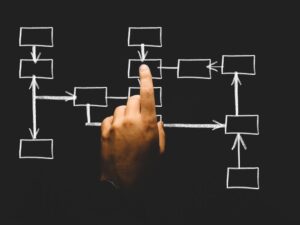

 If you are in sales, you are most likely goal-oriented and performance-driven. Your ability to win business – to convert leads into closed business situations – becomes your report card. And if you are a successful salesperson (or working to become one), you most likely focus on your new situations and pipeline, constantly working the sale and finding the path to closing that piece of business.
If you are in sales, you are most likely goal-oriented and performance-driven. Your ability to win business – to convert leads into closed business situations – becomes your report card. And if you are a successful salesperson (or working to become one), you most likely focus on your new situations and pipeline, constantly working the sale and finding the path to closing that piece of business.
How would you like to put yourself ahead of the rest?
Win / Loss Analysis is a game changer. No longer are you just looking at a scoreboard – how many deals did you close and how many did you loss? Win / Loss takes you beyond the score and moves into your performance, helping you learn the real reasons that drove a prospect to a certain decision.
This is information you need to know. The most important way to close more business is to learn what your clients and prospects are thinking at every stage of the sales experience. With this intel, you can move ahead of your competition by using real, actionable feedback to improve your performance in the next opportunity.
A Win / Loss program will help you:
In the current competitive market, success goes beyond simply keeping score of wins and losses. Sales professionals aiming to stay ahead of the curve are turning to Win / Loss Analysis for a deeper understanding of their performance. A Win / Loss program not only helps improve messaging and effectiveness but also sheds light on competitors’ successes and identifies drivers for closing new business. This approach encourages continuous improvement across the entire sales process, from initial rapport-building to sealing the deal, empowering sales professionals to enhance their performance and increase their chances of winning business. Consider how elevated your sales activity could be if you were receiving in-depth, post-sales debriefs after each and every decision in your pipeline.
So how can you best use Win / Loss for sales success? Try some of these helpful resources:
From a Good Sales Call to a Great Sales Call
 In our last blog, we covered the benefits of using a formal interview guide when conducting a win / loss interview. Now, we want to go a level a deeper and discuss what types of questions you should be writing down before-hand, so you can be the most prepared going into the interview with prospects.
In our last blog, we covered the benefits of using a formal interview guide when conducting a win / loss interview. Now, we want to go a level a deeper and discuss what types of questions you should be writing down before-hand, so you can be the most prepared going into the interview with prospects.
Search Criteria: One of the main reasons salespeople lose deals is they do not accurately understand the unique needs of their prospects. It is important in a win / loss interview to transport the respondent back to their thought process at the beginning of their search and ask questions like “What business problems were you trying to solve with the acquisition of a new solution?” and “What were the main attributes you were looking at to differentiate amongst vendors?” These questions help identify what areas the prospect was looking for your sales team to address during the sales process. By the end of the interview, you should make sure it is clear whether the prospect felt your team was able to address these unique needs.
Top-of-Mind Strengths and Weaknesses: Qualitative strength and weakness questions are open-ended questions designed to let the prospect think and answer in free-form. These questions can be as simple as “What were our strong points?” or “What could we improve on?” Be sure these are totally open-ended questions. Do not “lead the witness” with questions such as “Was our brand seen as a strength or weakness of the company?” You can ask questions like that later in the interview, but top-of-mind strength and weakness questions are important to determine the prospect’s true perceptions of your organization, with no outside influence.
Benchmarking / Competitive Intelligence: In addition to collecting open-ended, qualitative feedback, it is also important to use your win / loss interview to collect quantitative data. Having a section where you ask the prospect to rate your organization and a competitor on a number of rating scale questions not only gives you those quantitative statistics, but also provides a fair amount of competitive intelligence. In an interview on a loss decision, ask the prospects to rate your company to the winning provider. In a winning situation, do the same but for the runner up, or a specific competitor you are particularly interested in. Benchmarking questions should come towards the end of your survey because if the client senses the interview is coming to an end they might be more willing to give more information about the competition. It also may force them to focus on and assign ratings to specific attributes they had not thought of yet.
Decision Drivers: It is the most fundamental question of a win / loss interview: “Which vendor did you select and what were the top reasons for your choice?” In looking at the answers to this question, remember back to the question asking what the prospect was focused on at the beginning of the search, and see if anything changed throughout the search process.
These types of questions will give you the foundation for a successful win / loss interview. As you draft your interview guide, be sure to fill in with other questions focusing on the sales process, product / service offering, pricing, and deal-specific areas. But with these tips, you are well on your way to drafting your own interview guide for yourself!
 Win / loss may seem simple: close a deal, call the buyer, find out why they selected you or a competitor. At a high level these steps may seem straightforward, but they are a lot more complicated than what meets the eye.
Win / loss may seem simple: close a deal, call the buyer, find out why they selected you or a competitor. At a high level these steps may seem straightforward, but they are a lot more complicated than what meets the eye.
While debriefing with every single opportunity is a noble objective, it is unrealistic. If you have the right best practices though, you can select the right prospect organizations and the right contacts to engage with, and get on your way to developing a strong feedback mechanism. The following best practices can get you started:
At the Deal / Opportunity Level
There are a multitude of ways to segment or filter your deal-flow by in order to decide which of your prospects to call on. Here are some of the most beneficial to successful win / loss programs:
At the Contact Level
After deciding which deals to focus on, it is critical to make sure you speak with the right person at the prospect organization. Often in complex sales situations there is one key buyer, but many influencers from numerous different departments: the relevant line of business, IT, finance, and of course, procurement.
To gather the best win / loss feedback, remember to not get stuck in procurement. While the procurement department may have influence, they are often limited in the level of detail they can provide when describing the prospect’s full buying criteria and evaluation process. Getting in touch with the ultimate decision maker is the absolute best practice, as they will be able to provide access into their mindset throughout the sales process and ultimate decision.
In some scenarios there are heavy influencers or more than one decision maker, for instance a consultant may have been involved, or both IT and the line of business in a software sale. In these situations, it can be beneficial to interview multiple constituents to obtain the most well-rounded feedback possible.
After identifying who to contact for your interviews, remember some of the best practices for actually having the conversation with them. But by following the best practices above, you’ve already completed half the battle of conducting a win / loss interview.